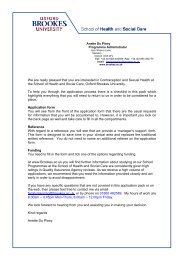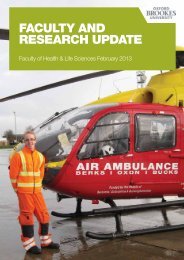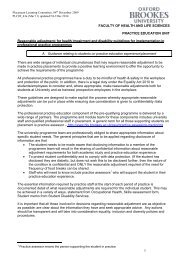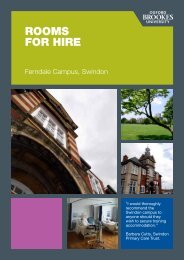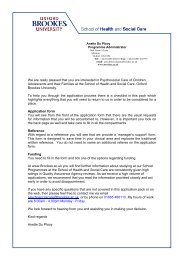faculty and research update - Faculty of Health and Life Sciences
faculty and research update - Faculty of Health and Life Sciences
faculty and research update - Faculty of Health and Life Sciences
- No tags were found...
You also want an ePaper? Increase the reach of your titles
YUMPU automatically turns print PDFs into web optimized ePapers that Google loves.
FACULTY ANDRESEARCH UPDATE<strong>Faculty</strong> <strong>of</strong> <strong>Health</strong> & <strong>Life</strong> <strong>Sciences</strong> February 2013
Projects& more Postgraduate Symposium 3A Day in the <strong>Life</strong> <strong>of</strong> an Air Ambulance 42nd Oxford Functional Food Conference 5News in Brief 6Events 9Research & Consultancy Bids <strong>and</strong> Awards 11WelcomeWelcome to this edition <strong>of</strong> the newsletter celebrating some <strong>of</strong> thelatest staff <strong>and</strong> student activities <strong>and</strong> successes across the <strong>faculty</strong>.There are also events advertised that you might like to put in your diaries!To keep future editions interesting <strong>and</strong> relevant we need a constantsupply <strong>of</strong> news stories so please keep sending them to:fhls-news@brookes.ac.ukPlease do read on <strong>and</strong> enjoy!June Girvin, PVC DeanLinda King, Associate Dean,Research <strong>and</strong> Knowledge Exchange2 Research News
A Day in the <strong>Life</strong><strong>of</strong> an Air AmbulanceBy Sam Willis, Senior Lecturer in Paramedic Emergency Careinform the pilot <strong>and</strong> to not assume that thepilot has seen it. Again, if a warning lightshows <strong>and</strong> the pilot doesn’t appear to haveresponded to it that I should speak up. Thisteam approach clearly addresses humanfactors <strong>and</strong> strengthens team working,reducing the possibility <strong>of</strong> nasty incidentsfrom occurring. At this point I was startingto miss the safety <strong>of</strong> my desk.We only received one call that day but evenso the patient we attended needed help.On arrival a paramedic crew was already onscene <strong>and</strong> it was a nice surprise to realisethat it was an ex Oxford Brookes Universitystudent.On arrival at the hospital, while h<strong>and</strong>ing overto hospital staff, I met another ex-OxfordBrookes university student paramedic aswell as a current student paramedic. Itwas great to see how our teaching hadtranspired into practice.The air ambulance is based at RAF Bensonin Oxfordshire <strong>and</strong> flies from dusk to dawn.It flies in most weathers, but during severeweather the HEMS crew respond to callsin the L<strong>and</strong>rover ambulance. The crewusually consists <strong>of</strong> 2 paramedics <strong>and</strong> aConsultant who has a speciality in trauma<strong>and</strong> emergency care. The emergency callsthey attend are <strong>of</strong> the most serious naturefor example major trauma, cardiac arrests<strong>and</strong> drownings.On my observation day I arrived at the RAFbase in time for a 0700 start where I had tosign in <strong>and</strong> have my photo taken before Iwas even allowed onto the RAF base. I wasthen escorted to the air ambulance site bythe paramedic. The base also houses thepolice helicopter alongside the RAF.As this was my first visit to the site thefirst discussion that took place was aboutsafety. I was told about the procedure <strong>of</strong>4 Research NewsRachel Decaux (A/E Consultant), Andrew Colledge (Paramedic), Sam WillisOn Friday 14th December 2012 I was given an opportunity tojoin the Thames Valley <strong>and</strong> Chiltern Air Ambulance for a shift onthe helicopter. During my career as a lecturer I have always hadan involvement with the Helicopter Emergency Medical Service(HEMS) in one way or the other, usually by taking students to visitthe helipad. This was the first time I was <strong>of</strong>fered the chance towork with the HEMS crew as a paramedic.getting into <strong>and</strong> out <strong>of</strong> the helicopter <strong>and</strong>was warned <strong>of</strong> the importance <strong>of</strong> followingthe rules closely. Even though I did need ahaircut I did not want one that close!I was immediately impressed by the waythe crew respected ‘human factors’ <strong>and</strong>‘crew resource management’. Theseterms have existed within aviation sincethe 1950s <strong>and</strong> have recently been taughtin paramedic programmes, including thedegree at Oxford Brookes. They relate tothe ways that humans interact with theirworking environment <strong>and</strong> recognise theeffects <strong>of</strong> a unique set <strong>of</strong> characteristicssuch as fatigue, stress <strong>and</strong> role conflicton paramedic performance. All <strong>of</strong> thesecan have life altering consequences for thepatient.The pre-flight safety brief also addressedhuman factors, <strong>and</strong> I was told that if duringthe flight I saw another aircraft, that I shouldDuring the quiet periods we had anopportunity to identify the equipment <strong>and</strong>protocols that HEMS <strong>of</strong>fers that routineambulances do not. For example they useimmobilisation equipment that is lighter <strong>and</strong>easier to use, <strong>and</strong> the drugs they carry suchas Ketamine <strong>and</strong> other sedatory drugs thatcurrent paramedics don’t yet carry. We alsohad time to have a run through <strong>of</strong> a practiceimmobilisation on a training manikin.Overall the day was massively beneficialto my own development, not to mention apositive step for the University by promotingthe paramedic programme <strong>and</strong> increasingawareness <strong>of</strong> how the programme works,as well as <strong>of</strong>fering an element <strong>of</strong> studentsupport. I was invited back to do an 0600shift on Saturday but I was craving sleep atthat point.
2 nd Food ConferenceOxford FunctionalThe Functional Food Centrehosted its 2nd InternationalFunctional Food Conference onthe 13th <strong>and</strong> 14th <strong>of</strong> November2012. After a successful 1stconference in 2010, it wasdecided to host this eventbiennially.The 2012 conference was jointly hosted forthe second time with the Richardson Centrefor Functional Foods <strong>and</strong> Nutraceuticals(University <strong>of</strong> Manitoba) <strong>and</strong> focussed onthe role <strong>of</strong> functional foods in helping totackle obesity, diabetes <strong>and</strong> inflammation.A distinguished assembly <strong>of</strong> speakers fromthe UK, Europe, USA <strong>and</strong> Canada includingour very own Dr Lisa Ryan presentedtheir latest <strong>research</strong> <strong>and</strong> insights. Theconference received an endorsement forContinuous Pr<strong>of</strong>essional Development fromthe pr<strong>of</strong>essional body, the Association forNutrition.The event was well attended <strong>and</strong>, thisyear, special rates for Oxford Brookesstudents <strong>and</strong> alumni were introduced. The<strong>Faculty</strong> also sponsored 4 places in support<strong>of</strong> colleagues’ personal development.Feedback scores from attendees wereexcellent with an average rating <strong>of</strong> 4.2out <strong>of</strong> a possible 5 for the speakerpresentations. The majority <strong>of</strong> respondentsalso rated the conference overall, theprogramme overall <strong>and</strong> the registrationprocess as excellent. Our Canadiancolleagues were very complimentary aboutthe whole experience.The plenary lecture on day 1 was givenby Dr. Malcolm Kendrick (author <strong>of</strong> ‘TheGreat Cholesterol Con’). Using his ownexperience <strong>of</strong> challenging the widelyaccepted belief that cholesterol causesheart disease, he set the scene bychallenging the assembled scientists toaccurately <strong>and</strong> clearly publish their resultseven when such results contradict currentthinking.Pr<strong>of</strong>essor Jason Halford (University <strong>of</strong>Liverpool <strong>and</strong> chair <strong>of</strong> the UK Associationfor the Study <strong>of</strong> Obesity) in his plenarylecture on day 2 highlighted the complexphysiological <strong>and</strong> psychological factorsin play in controlling human appetite <strong>and</strong>the subsequent issues in <strong>research</strong> studieswhen trying to prove an effect.Pr<strong>of</strong>essor Jason HalfordA wide ranging programme considered:• whether evidence currently exists that functional foods can positively impacton appetite <strong>and</strong> weight management;• the efficacy <strong>of</strong> natural ingredients in diabetes control;• the use <strong>of</strong> functional ingredients to modulate the metabolic syndrome (obesity,diabetes, cardiovascular disease etc.);• the role <strong>of</strong> cell culture models in assessing bioavailability <strong>and</strong> bioaccessibility<strong>of</strong> food ingredients prior to complex <strong>and</strong> expensive human studies as apotential to improve the achievement <strong>of</strong> positive outcomes.The development <strong>of</strong> functional ingredients<strong>and</strong> foods is a growth area from both a<strong>research</strong> <strong>and</strong> a commercial perspective.Taking an idea from concept to the finalproduct requires a great deal <strong>of</strong> investmentboth from a time <strong>and</strong> funding perspective.The benefits are only ever finally proven instudies involving human subjects.Different regulatory regimes worldwidehave the ability to either stifle or facilitatesuch innovation yet the evidence suggeststhat benefits at the individual, population<strong>and</strong> economic level can be delivered. Thespeed <strong>of</strong> development will depend on manyeconomic <strong>and</strong> political factors. This leavesplenty <strong>of</strong> scope for the Functional FoodCentre to play a pivotal role.There were 2 poster sessions for thepresentation <strong>of</strong> new <strong>and</strong> novel <strong>research</strong>.The prize sponsored by Oxford BrookesUniversity <strong>and</strong> the University <strong>of</strong> Manitobafor the best student project was awarded toPeter Wootton-Beard (PhD student in theFunctional Food Centre) by an independentjudging panel. The Innovation Prize donatedby Food <strong>and</strong> Function was awarded toCaroline Montelius (PhD student from LundUniversity).Peter Wootton-Beard collecting his student prizeThe planning <strong>and</strong> delivery <strong>of</strong> the conferenceinvolved all members <strong>of</strong> the FunctionalFood Centre <strong>and</strong> many other colleaguesacross the University. Many thanks <strong>and</strong>much praise goes to them for making thisconference such a great success. Wehave already had some post conferencepublicity <strong>and</strong> we plan more. Two excitingcollaboration opportunities have also arisen.Visit http://www.shs.brookes.ac.uk/<strong>research</strong>/functional-food/conference forfurther conference highlights.March 2013 5
News inBriefPhD Student Award WinnerSuzanne Watts, second yearPhD student in the Department<strong>of</strong> Psychology, Social Work <strong>and</strong>Public <strong>Health</strong> has been awarded theRoyal College <strong>of</strong> Nursing MarjorieSimpson New Researcher Award2013. The award covers the cost<strong>of</strong> conference fees, travel <strong>and</strong>accommodation for Suzanne toattend the annual Royal College<strong>of</strong> Nursing International ResearchConference to be held in Belfastlater this year. At the conferenceSuzanne will be presenting a posterdetailing how she addressed theethical challenges in the design <strong>of</strong>her <strong>research</strong> which is a multiplecase study exploring child protectionreferrals from primary health care tochild social care. Suzanne, who is amember <strong>of</strong> the Children <strong>and</strong> FamiliesResearch Group is supervised byDr Jane Appleton <strong>and</strong> Pr<strong>of</strong>essorMargaret Harris <strong>and</strong> is supportedby a <strong>Faculty</strong> funded studentship onthe Interdisciplinary Doctoral TrainingProgramme for Children <strong>and</strong> YoungPeople.Senior Lecturer Awarded TravelScholarshipObrey Alexis, Senior Lecturer in AdultNursing, has been awarded a Sant<strong>and</strong>erTravel Research Scholarship to exploreglobal health care <strong>and</strong> its developmentin the United States <strong>of</strong> America. Whilstthere, he will visit the University <strong>of</strong>Pennsylvania, The John Hopkins University<strong>and</strong> the University <strong>of</strong> Columbia <strong>and</strong> willgain insights into global health care fromacademics <strong>and</strong> those who are part <strong>of</strong> theglobal health care community. Obrey aimsto disseminate the findings in the form <strong>of</strong>a seminar session to staff <strong>and</strong> students atOxford Brookes University enabling themto have a better underst<strong>and</strong>ing <strong>of</strong> globalhealth care. This award will no doubtdevelop Obrey pr<strong>of</strong>essionally <strong>and</strong> theexpert knowledge gained will enable himto inform the nursing curriculum within theAdult nursing programme.Climate Change <strong>and</strong> the Accliphot ProjectAccliphot is a major <strong>and</strong> exiting new project funded as part <strong>of</strong> the European Union’sMarie Curie Initial Training Network scheme. The overall aims <strong>of</strong> the project are toidentify how plants might alter their biochemistry in response to climate change, whetheror not it is possible to accelerate this adaptation via specific interventions, <strong>and</strong> whethersuch underst<strong>and</strong>ing can be applied for practical purposes (e.g. obtaining higher bi<strong>of</strong>uelyields by engineering organisms that can take advantage <strong>of</strong> higher light levels).The network is comprised <strong>of</strong> thirteen international academic <strong>and</strong> industrial partnerseach <strong>of</strong> whom will be employing one or more early stage <strong>research</strong>ers to work on variousaspects <strong>of</strong> the project. The Cell Systems Modelling Group will be appointing two <strong>of</strong>these <strong>research</strong>ers to develop metabolic models <strong>of</strong> the relevant organisms. These willthen be used as an aid to experimental design <strong>and</strong> interpretation.Further details can be found on the project website -http://www.accliphot.euDr Ross Sadler has been awardedan NIHR grant for “Predictingcardiovascular risk in Rheumatoid arthritispatients: Addition <strong>of</strong> microparticle <strong>and</strong>immunological biomarkers to currentcardiovascular risk scores”Rheumatoid arthritis (RA) is a chronicautoimmune disease that affects approx600,000 people in the UK. Rheumatoidarthritis currently has no cure <strong>and</strong> theimmunological mechanism by whichthe disease develops remains unclear.Interestingly, the biggest cause <strong>of</strong>death in these patients is heart orcardiovascular disease (CVD). ThoseRA patients who are diagnosed withcardiovascular illness are twice as likelyto die within 1 year <strong>of</strong> their cardiovasculardiagnosis that someone who has CVDbut no RA.Currently, CVD is predicted according toa patient’s ‘risk’. This risk is calculatedfrom a number <strong>of</strong> different factors aboutthe patient including smoking history,body mass index (BMI) <strong>and</strong> cholesterollevels. These factors are compiled into aformulation that can predict the likelihood<strong>of</strong> the patient developing CVD, known asthe Framingham risk score (FRS).Microparticles are small cell-derivedmembrane-bound vesicles producedby cells in the vascular system at times<strong>of</strong> physiological stress to the body.Previous studies have shown thatincreases in particular microparticlesare associated with various groups <strong>of</strong>patients who suffer from a cardiovascularcomplication <strong>and</strong> that these can increasethe accuracy <strong>of</strong> a risk score for thesepatients when predicting cardiovasculardisease. The second biggest cause <strong>of</strong>co-morbidity <strong>and</strong> mortality in RA patientsis infection <strong>and</strong> this has been shown tobe independent <strong>of</strong> immunosuppressivemedication, indicating a wider effect<strong>of</strong> immune dysregulation in thesepatients than simply their autoimmunemanifestations.In this study, levels <strong>of</strong> microparticles <strong>and</strong>immune function will be assessed inpatients with established RA who alsohave cardiovascular disease <strong>and</strong> thesewill be compared to relevant controls.We will try to establish if signaturemicroparticle <strong>and</strong> immune function pr<strong>of</strong>ilefactors exist that appear to be presentsignificantly in this RA + CVD group.These c<strong>and</strong>idate biomarkers will be thenassessed for their clinical value, eitheron their own or integrated into existing‘risk’ scores, in predicting cardiovasculardisease in newly diagnosed RA patients.With this work, it is hoped that moreaccurate evaluation <strong>of</strong> early RA patientscould lead to earlier intervention <strong>and</strong>better management <strong>of</strong> patients leadingto a decrease in both morbidity <strong>and</strong>mortality.6 Research News
Biotech Partnership with India inSearch for Sustainable FuelsOxford Brookes University has joinedforces with the International Centre forGenetic Engineering <strong>and</strong> Biotechnology(ICGEB) <strong>and</strong> Jawaharlal Nehru University(JNU) in Delhi to develop cheap <strong>and</strong>sustainable bi<strong>of</strong>uels in a project funded byan Indian Partnering Award from the UK’sBiotechnology <strong>and</strong> Biological <strong>Sciences</strong>Research Council (BBSRC).The project mayexp<strong>and</strong> to involvepartner institutionselsewhere inIndia <strong>and</strong> theUK. It follows asuccessful fouryearcollaborationbetweenPr<strong>of</strong>essor DavidFell (pictured) from the Department <strong>of</strong>Biological <strong>and</strong> Medical <strong>Sciences</strong> at OxfordBrookes <strong>and</strong> Dr Sudip Kundu, from theDepartment <strong>of</strong> Biophysics, MolecularBiology <strong>and</strong> Bioinformatics at theWe are delighted to bedeveloping this partnership <strong>and</strong>hope to win further fundingfor more extensive <strong>research</strong>collaborations. This type <strong>of</strong>partnership provides tremendousadvantages for all parties: we take acomputational modelling approachwhilst our Indian colleagues have theexperience <strong>and</strong> facilities to test out ourpredictions, rather than just relying onpro<strong>of</strong> <strong>of</strong> principle. David FellUniversity <strong>of</strong> Calcutta which focussed onthe metabolic properties <strong>of</strong> rice.Pr<strong>of</strong> Fell was in a visiting party fromUK universities, funded by the BBSRC,that met with the Indian Government’sDepartment <strong>of</strong> Biotechnology (DBT) <strong>and</strong>Indian scientists in Delhi in October 2011to promote <strong>and</strong> facilitate collaborativebioenergy <strong>research</strong> by <strong>research</strong>ers <strong>and</strong>academics from both the UK <strong>and</strong> India.They agreed to explore three possiblesources <strong>of</strong> bi<strong>of</strong>uels: planktonic algae,seaweed <strong>and</strong> the by-products <strong>of</strong> riceproduction - rice straw - to avoid competitionbetween bi<strong>of</strong>uel <strong>and</strong> food production. It washere that he met Dr Shams Yazdani (ICGEB)<strong>and</strong> Pr<strong>of</strong>essor K J Mukherjee (JNU).David returned to Delhi in November2012 with colleagues to deliver a weeklongpractical course for 12 postgraduate<strong>research</strong>ers <strong>and</strong> staff. (See next page.)During the week, students were selectedto visit the UK in 2013 to work at OxfordBrookes <strong>and</strong> the University <strong>of</strong> Abderdeen.The latest project aims to build computermodels <strong>of</strong> the metabolism <strong>of</strong> bacteria <strong>and</strong>then design <strong>and</strong> implement changes thatcould help provide a credible bi<strong>of</strong>uel for India.Congratulations go toDr Bridget Taylor,Department <strong>of</strong> Clinical <strong>Health</strong> Carewho has been successfully awardedher PhD for her work ‘Couples living intwilight: a Heideggerian hermeneuticstudy <strong>of</strong> sexuality <strong>and</strong> intimacy in lifelimitingillness’.How We Find What We Are Looking ForWhat we know about an object we are looking for plays animportant role in how effectively we find it.According to <strong>research</strong> from Early Career FellowDr Giles AndersonThe series <strong>of</strong> eye-tracking studies, to be published in the journalVision Research under the title ‘Top-down Guidance <strong>of</strong> EyeMovements in Conjunction Search’, indicate that knowingsomething’s colour allows us to spot an item (such as yourkeys) far quicker than prior knowledge <strong>of</strong> other attributes (e.g.,its visual orientation). Such differences in the functioning <strong>of</strong> thevisual system have real-world applications, particularly whenimprovements in visual processing are <strong>of</strong> paramount importance(e.g., emergency or traffic signage).Thyroid Hormone Deficiency <strong>and</strong>Testicular Structure in the OvineFetusAlison Forhead has been awarded anAcademic Scholarship Award <strong>of</strong> £5550from the Society for Reproduction <strong>and</strong>Fertility.Her project will examine the effects<strong>of</strong> low levels <strong>of</strong> thyroid hormones(hypothyroidism) before birth on thestructure <strong>and</strong> function <strong>of</strong> the fetal testis.Development <strong>of</strong> the testis in the fetus<strong>and</strong> newborn can influence reproductivefunction <strong>and</strong> fertility in adult life. Thyroidhormone receptors are present in the fetaltestis, <strong>and</strong> congenital hypothyroidism,the most common congenital endocrinedisorder, has been shown to impair malefertility in both clinical <strong>and</strong> experimentalanimal studies.This study will provide novel pilot data forfuture <strong>research</strong> proposals to explore themechanisms <strong>of</strong> thyroid hormone actionin the fetal testis, <strong>and</strong> the findings maycontribute to the underst<strong>and</strong>ing <strong>and</strong>management <strong>of</strong> long-term reproductivefunction in congenital hypothyroidism.Richard Newton, celebrating hissuccessful PhD Viva, on Friday 11January. He is with the two examiners,Pr<strong>of</strong> Ed Elbers, University <strong>of</strong> Utrecht,The Netherl<strong>and</strong>s, <strong>and</strong> Dr Mary Wilde,Oxford Brookes School <strong>of</strong> Education(<strong>and</strong> his Director <strong>of</strong> Studies – Guida deAbreu).Richard was supported by a UniversityScholarship from the Doctoral Trainingin Children <strong>and</strong> Young People, <strong>and</strong>his <strong>research</strong> programme involvedcollaboration between Psychology &Education.His thesis was titled ‘Parent-childmathematical interaction: experiences,identity <strong>and</strong> activity’. He was supervisedby Pr<strong>of</strong>essor Guida de Abreu(Psychology, director <strong>of</strong> studies) <strong>and</strong>Georgina Glenny (Education, secondsupervisor).March 2013 7
One-Week WorkshopIn November 2012 David Fell <strong>and</strong> MarkPoolman <strong>of</strong> the Cell Systems ModellingGroup, Oliver Ebenhoeh (University <strong>of</strong>Aberdeen) <strong>and</strong> Hassan Hartman (PhDstudent in our group) ran a one weekworkshop for post-graduate students<strong>and</strong> interested others at the University<strong>of</strong> Delhi, introducing mathematical <strong>and</strong>computational analysis <strong>of</strong> metabolicsystems. As with previous workshops,we were incredibly impressed with theenthusiastic <strong>and</strong> friendly attitude <strong>of</strong> theIndian students, especially considering thesomewhat ad-hoc nature <strong>of</strong> the practicalarrangements - not all <strong>of</strong> the facilitieswere yet fully functional <strong>and</strong> this wasfurther compounded by the heavy securitynecessitated by a visit from the AustralianPrime Minister (who didn’t even attend theworkshop).The project aims are to:- use workshops to spread knowledge <strong>of</strong> modelling techniques developed by theUK partners;- mutually develop systems biology approaches to bioenergy <strong>research</strong>;- exchange <strong>research</strong>ers to work on areas <strong>of</strong> mutual interest.The project runs from 2012 to 2016.This workshop was the first one organisedunder our new UK-India partnering award.The award will run over the next threeyears so we are looking forward to thenext visit!To conclude an earlier UK-India partneringaward with Dr Sudip Kundu at theUniversity <strong>of</strong> Calcutta, we organised aconference in Kolkata (aka Calcutta) atthe end <strong>of</strong> January, involving a number<strong>of</strong> UK <strong>and</strong> Indian scientists, with the title‘Systems Biology <strong>of</strong> Metabolism, Stress<strong>and</strong> Disease’.This promised to be a fascinating meeting,bringing together <strong>research</strong>ers from awide range <strong>of</strong> areas <strong>of</strong> biology (plant,microbial, human) <strong>and</strong> an equally diverserange <strong>of</strong> approaches, from theoretical toexperimental. We will report the results <strong>of</strong>our project on modelling rice metabolism.Oxford Brookes participants, David Fell,Mark Poolman <strong>and</strong> Christine Faulkner,were joined by Dr Nick Kruger from Plant<strong>Sciences</strong>, University <strong>of</strong> Oxford. The Indianspeakers come not only from Calcutta butfrom around India.More details can be found athttp://mudshark.brookes.ac.uk/Meetings/Kolkata2013Brookes Academic Featured inthe Daily MailImages <strong>of</strong> the internal world <strong>of</strong> plantstaken by Dr John Runions, Readerin Cell <strong>and</strong> Molecular Biology, havefeatured in the Daily Mail. The images,originally submitted to the onlinejournal Cell, demonstrate the beauty,intricacy <strong>and</strong> dynamism <strong>of</strong> plants whenphotographed at microscopic level.From the outside plants mayappear less than mobile, butpeer inside <strong>and</strong> you’ll see averitable motorway <strong>of</strong> activity.For proper health <strong>and</strong> development,resources like water <strong>and</strong> nutrients musteasily get from one part <strong>of</strong> the plantto another; in vascular plants, theseresources can traverse the plant viavascular bundles that are made up <strong>of</strong>many different cell types.John RunionsMore <strong>of</strong> John’s images <strong>and</strong> others submitted by colleagues at the University <strong>of</strong>Cambridge, can be found here:http://www.dailymail.co.uk/sciencetech/article-2215052/The-complexity-intricacy-Mother-Nature-revealed-incredible-pictures-plants--seen-inside.html8 Research News
Brookes Students Attend CAIPEConferenceOn the 9th November 2012, threethird year Children’s nurses attendeda student conference focusing oninterpr<strong>of</strong>essional learning, run by theCentre For The Advancement OfInterpr<strong>of</strong>essional Education (CAIPE).The day consisted <strong>of</strong> various speakers<strong>and</strong> a breakout discussion in smallgroups. A highlight was the speakerKylie Jarvis, who has Down’s syndrome,demonstrating perfect public speakingskills on the importance <strong>of</strong> usinglanguage that is suitable for eachindividual patient <strong>and</strong> how to supportself-advocacy in people with a learningdisability using a MDT approach.The conference was also an excellentnetworking opportunity, we had thechance to meet <strong>and</strong> work with studentsfrom different universities, from varyingcourses. We would recommend joiningCAIPE for the conference opportunities<strong>and</strong> to stay up to date with IPE <strong>and</strong>other students.Public <strong>Health</strong> Student Gains Prestigious ScholarshipA student on the Masters in Public <strong>Health</strong> programme has received an award from the JohnHopkins Bloomberg School <strong>of</strong> Public <strong>Health</strong>. Evelyn Akinbunu, who is a full time internationalstudent from Ontario, Canada, received a scholarship to study for a Vaccine Policy Issuescourse taught in partnership with The Public <strong>Health</strong> Agency <strong>of</strong> Barcelona.Designed specifically for public health pr<strong>of</strong>essionals, the course was an intensive three-daycourse that featured renowned pr<strong>of</strong>essionals in the area <strong>of</strong> vaccine, including guest speakersfrom organizations such as WHO, LSHTM, Novartis, <strong>and</strong> the University <strong>of</strong> Barcelona.Evelyn commented:As a current student <strong>and</strong> novice in the field <strong>of</strong> public health, I was unsure <strong>of</strong>what to expect. However, the course took me on something I would like tocall a “vaccine journey”. Within the span <strong>of</strong> 72 hours, I was able to have anin-depth underst<strong>and</strong>ing <strong>of</strong> immunization programmes, the role <strong>of</strong> the internetin low uptake, <strong>research</strong> <strong>and</strong> design, vaccine safety, the debate <strong>of</strong> compulsoryvaccination, the challenges faced by developing countries <strong>and</strong> how to tacklethe general public’s lack <strong>of</strong> confidence in immunization.‘In between the talks, group activities were implemented to facilitate discussions,tackling vaccine policy case studies, <strong>and</strong> creating our own immunization program.I was unsure <strong>of</strong> what I would take away from this course, but I acquired a wealth <strong>of</strong>knowledge about a field unknown to me. It also made me aware <strong>of</strong> my ignorance inthe area <strong>of</strong> vaccinations. I took away many valuable lessons, but the one that stoodout to me is the need for better public health communication to the general public.This will restore the public’s confidence in vaccines <strong>and</strong> increase uptake.EventsFirst International SpiderWeb Meeting23-24 February, 2013Oxford Brookes University, UKDept. <strong>of</strong> Biological <strong>and</strong> Medical <strong>Sciences</strong>SpiderWeb is an alliance led by Dr. AlistairMcGregor (OBU), Dr. Evelyn Schwager(Havard University) <strong>and</strong> Dr. Niko Prpic-Schäper(Göttingen University) <strong>of</strong> several<strong>research</strong> groups who are interested in thedevelopment, evolution, phylogeny <strong>and</strong>diversity <strong>of</strong> spiders. SpiderWeb servesas a way to share <strong>and</strong> discuss ideas,knowledge, resources <strong>and</strong> materials. Datasharing <strong>and</strong> joint meetings further increasethe synergy, support common scientificprojects, <strong>and</strong> help to manage all availableresources economically.SpiderWeb will host its first meeting atOxford Brookes University in February, withinterested <strong>research</strong>ers from around the world!The meeting will include talks by members<strong>of</strong> the consortium, additional contributedtalks <strong>and</strong> posters, <strong>and</strong> two workshops todiscuss current <strong>and</strong> future progress in spidergenomics <strong>and</strong> functional tools.Organizers: Alistair McGregor, Evelyn Schwager,Niko Prpic-SchäperPlenary presentations: Hiroki Oda, Michael AkamConfirmed speakers: Yasuko Akiyama-Oda, Jonathan Coddington, Wim Damen,Cass<strong>and</strong>ra Extavour, Franziska Anni Franke,Beate Mittmann, Matthias Pechmann,Siegfried Roth, Evelyn Schwager, PrashantSharma, Angelika StollewerkworkshopResearch that breaks your heart: The emotional impact <strong>of</strong> <strong>research</strong> on the <strong>research</strong>er11 March, Marston Road CampusMarta Wanat (Department <strong>of</strong> Clinical <strong>Health</strong> Care) <strong>and</strong> Tracy McAteer (Department <strong>of</strong> Psychology, Social Work & Public <strong>Health</strong>) who areboth PhD Researchers have managed to secure funding from The Psychology Postgraduate Affairs Group to run a one day workshop.It is aimed at postgraduates who are currently conducting <strong>research</strong> on emotionally sensitive topics.The invited speakers include Dr Juliet Rayment (City University London), Bridget Taylor, Marta Wanat, Tracy McAteer (Oxford BrookesUniversity) <strong>and</strong> Ben Hicks (Bournemouth University).If you would like more information, please email Marta Wanat (marta.wanat-2011@brookes.ac.uk) orTracy Mcateer (tmcateer@brookes.ac.uk) who are organising this workshop.March 2013 9
Tiger Conservation into the21st CenturyOpen Lecture SeriesMain Lecture Theatre27 February 6.00pmPr<strong>of</strong>essor Stewart Thompson’sinaugural Pr<strong>of</strong>essorial LectureIt is not easy to see a tiger – even if you arelooking in the right place! At the start <strong>of</strong>the 20th century there were an estimated100,000 worldwide. Today, although theactual number is subject to disagreementbetween tiger range Governments, tigerbiologists <strong>and</strong> Forest <strong>of</strong>ficials, there isconsensus that this number is somewherebetween 3 - 5,000.Some tiger biologists prefer to think <strong>of</strong>them as having sub-species – <strong>of</strong> the ninesub-species they recognise, three, arealready gone, with a fourth functionallyextinct. Others believe there are only tw<strong>of</strong>orms – the ‘nominate’ (typical) <strong>and</strong> the‘Sunda Isl<strong>and</strong>s’ (Indonesian) tiger. Whilstthis lumping versus splitting debate hassome conservation implications, the factremains that whichever way we look at it –tigers are in big trouble.Today wildlife conservation has movedaway from a species-centric to al<strong>and</strong>scape or ecosystem approach.Modern tiger conservation centres aroundthe identification, maintenance <strong>and</strong>protection <strong>of</strong> “Tiger Conservation Units”or “Critical Tiger Habitat”. One recentpiece <strong>of</strong> <strong>research</strong> identified 160 distinctl<strong>and</strong>scapes where tigers are found. Ofthese 60% were calculated to be unviable,with the vast majority <strong>of</strong> the 160 havingfewer than 25 breeding adults. Perhapsthe most sobering aspect <strong>of</strong> this workJ. Patrick Fischerwas the conclusion that as few as six tigerl<strong>and</strong>scapes exist that have more thanthe minimum number <strong>of</strong> breeding adultspopulation biologists consider necessaryto ensure a viable population in perpetuity.At face value tigers have scores <strong>of</strong> friends.There are numerous NGO’s pouringmillions <strong>of</strong> pounds into their conservationannually. Add to this the multi-million dollartourism industry that surrounds them <strong>and</strong>clearly they are <strong>of</strong> major economic <strong>and</strong>social importance. The recent decisionto close all Indian tiger reserves to tourismwas met with outcry from the tens <strong>of</strong>thous<strong>and</strong>s <strong>of</strong> individuals who rely, directlyor indirectly, upon them for their livelihood.The tiger tourism industry rallied round <strong>and</strong>the decision was reversed, but for howlong? For many observers the removal<strong>of</strong> tiger tourism will be their death knell.Therefore developing an underst<strong>and</strong>ing <strong>of</strong>tourism impacts to both tigers <strong>and</strong> humansis vital if tigers are to have a chance <strong>of</strong>survival into the 21st century <strong>and</strong> beyond.Conservation biologists are firmly <strong>of</strong> thebelief that we are at a cross-roads forthe world’s tigers. Current protectionmechanisms are not working <strong>and</strong> a newapproach to tiger conservation must bearrived at <strong>and</strong> quickly! Without this newapproach the price will be the loss <strong>of</strong>the tiger <strong>and</strong> the admission that we didnot have the ability to save the planet’smost iconic species. As part <strong>of</strong> theOpen Lecture series Stewart Thompsonwill therefore explore a number <strong>of</strong> keyquestions linked to how best we canprotect <strong>and</strong> exp<strong>and</strong> their remainingpopulations <strong>and</strong> asks what chance dotigers have in their remaining strongholds?Forthcoming EventsBrookes Science Bazaar, 16 March 2013:https://shsc-int.brookes.ac.uk/blogs/outreach/?p=157deadline for online activity registration is 7 January 2013.Attention: We only called it ‘Science Bazaar’ because ‘Evidence based Research Bazaar’ isn’t catchy.ALL <strong>research</strong>ers from FHLS are invited to run an activity based on their <strong>research</strong> field.Darwin, Sex <strong>and</strong> Sexual Selection, 27 March 2013 at 6pm:The <strong>Faculty</strong> Annual Research Lecture by Pr<strong>of</strong>essor Tim BirkheadPlaces can be booked at www.brookes.ac.uk/about/eventsAmazing Acts Festival, 7-10 May 2013:https://shsc-int.brookes.ac.uk/blogs/outreach/?p=176registering expression <strong>of</strong> interest now.Please have a look <strong>and</strong> if you have any questions or would like to discuss ideas, drop Anne Osterriederan email.Statslink <strong>and</strong> Mathslink Short Courses for ResearchersStatistical Methods for Data Analysis 2, 11 <strong>and</strong> 12 June 201310 Research News



